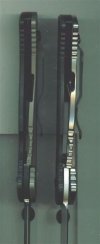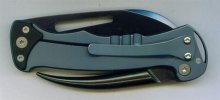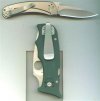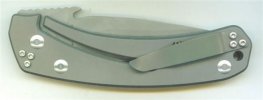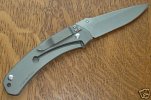Thanks
I don't believe it makes any real difference to be honest. I believe its just a matter of personal preference really. The Combat Elite has a long cut also as do the Mission folders. If you look at some other production models like the HD7 by Emerson for example or several others from various years by other manufacturers you can actually see that some have cuts not only longer or shorter than others of the same model, but deeper or in different places on the lock altogether even though its the same model folder. I've noted length of the locks long cut being different as well as the actual width of the locks, detent ball positions, type of lock cuts made to spring the lock and more. Seems there is some variance from year to year and even in the same year models on others.
There is a lot of theories about which side of the lock is best to make your relief cut on but in my own testings I have seen no advanage to putting the lock relief cut on the outside vs the inside. I don't buy the theory that it is better on one side than the other. Just doesn't pan out in testing. Sal Glesser and I discussed this and he said he noted the same thing by the way.
However, I have noted that if the lock cut(s) is/are on the outside of the lock it can catch and interfere with pocket clips and how well the knife slides on and off the rim of the pocket. I've run into this on the JunkYardDog II frame lock knives I've converted to tip up carry for folks as well as some factory knives including the Strider PT which you cure by simply opting to lose some pocket retention in the clip after you lift it up. This is not noticed much until you get a knife mailed to you to convert to tip up carry that didn't come that way though. Then after you flip the clip and drill and thread holes you find out that the relief cut catches the pocket a bit due to the tension of the clip pushing your pants pocket seam into the cut out in the lock to make it hang up there. At times folks have reported to me that they dropped their knives from it snagging the pocket in the lock cut when carrying tip up. So, to me the lock cut on the outside is a negative that interferes with my clip positioning when asked to do a job. It doesn't mean that anyone else will see it that way though.
I've noted on more than one knife that the thinner the cut out is to make the bend to spring your lock the easier the lock is to operate. Another way to say that is that the locks with thin lock cuts will operate like a thin liner lock for how easy it is to manipulate it. Of course this also plays into how easy it would be to hyper extend it out the wrong way too when its that easy to move.
There is a drawback to the thinner lock cut scenario in my opinion and that is that if you happen to be someone that carries your frame lock with the pocket clip taken off. Most of the pocket clips are strategically positioned to block the lock from over travel, so removing the pocket clip will also make it easier to hyper extend the lock out too far the long way. Mick Strider wrote once how he decided to use the Hinderer lock stabalizer. Apparently he did just this type of hyper extension of the lock with his own knife even with the clip on the folder or someone he knew did. I don't exactly recall but the point is if you get carried away or if the lock sticks and you have to push it harder to make it release in a heated moment to close your blade those thinner lock cuts can come back to bite you.
The one other thing worth mention is that the thinner cut is one way to control the burn for how the lock defeats when and if it ever reaches a point where something has to give. In all honesty there are far worse ways to have a lock defeat than the way a properly made frame lock should behave in hard use. The thin lock cut helps to create that very situation where the maker hopes to control how the lock will behave under an extreme load. In other words the thin lock cut is purposely made to be the weak link in the chain as a measure of safety for the user. If made correctly the lock should defeat such that yes the lock mangles inward on one end of the lock cut and outward on the other end deforming the lock but the lock remains engaged to the blade and no one is seriously cut or injured, or if they are its not as bad as it could be had the lock not done its job while being ruined in the process. Thats best case scenario of course. Worse case? The contact at the interface of the lock and blade was not good and the lock sprung off the blade freeing it up where much more damage to your hand would occur I'm sure!
Back to lock cuts. I've fixed some smaller frame locks carried without the clips by the users from the Kershaw Vapor models, to Leeks to Buck Mayos and Emerson HD7s and a few other various brands for losing spring over the years but it is rare. Its also hard for me to know if they lost spring or just didn't come sprung enough from the factory to continue to self correct with wear so I just point out what I've seen without really knowing the cause for all of them. What can happen if this occurs is that the lock gets pushed too far out the wrong way and you lose some spring or in rare cases all of the spring to make it self correct and stay behind the blade to secure it. The tell is that its usually going to have some vertical clicking and movement in the blade and then folks notice something has changed with the lock and upon further inspection they usually notice its not traveling in as far or any further at all with wear.
Well, I hope that answers your questions Mike. Thanks for asking
Here is a scan of two different year models of Emerson HD 7 for your viewing pleasure.

In this case I know the one on the left is the older of the two shown here and you can probably tell with the naked eye from this scan that the older model was not sporting as thick of a slab of titanium as the new one. Whether or not this is what was done with all of them or just some variance in what they bought when available is unknown.
STR

